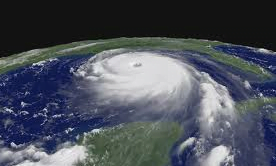The 2012 Atlantic Hurricane Season kicked off late last week. Here are two reasons why this season may be a doozy.
1) This map from the US Geological Survey which shows the percentage of beaches in the USA that would suffer erosion from even a weak, Category 1 hurricane make landfall.
Says the USGS:
-During a category 1 hurricane landfall in the Gulf of Mexico, waves increase water levels at the shoreline by 170% above surge alone. The predicted wave-driven component of shoreline water levels was 2.8 m, high enough to overwash the mean dune elevation along the U.S. Gulf coast, even without surges.
-For modeled conditions representing category 1 hurricane landfall, 99% of sandy beaches along the U.S. Gulf of Mexico coast are very likely (P>90%) to experience dune erosion, 71% are very likely to overwash, and 27% are very likely to inundate.
-For category 3 hurricane landfall, 92% of sandy beaches are very likely to overwash.
-For category 5 hurricane landfall, 89% of sandy beaches are very likely to inundate. Hurricanes are not required for significant coastal change in the Gulf region. Waves associated with tropical storms and winter cold fronts provide sufficient energy to put low-elevation beaches and dunes at risk to erosion.
2) A map of Haiti from the UN Office for the Coordination of Humanitarian Affairs showing 200,000 people who still live in temporary shelters as the hurricane season approaches.
The rainy season came earlier than expected this year. So far, flooding from heavy rains have resulted in the deaths of 22 people. Cholera is also still an acute problem. Cholera spreads by water and could be exacerbated by even a weak hurricane.
Post earthquake Haiti has so far avoided a direct-hit. But in 2008, back-to-back-to-back hurricanes devastated parts of the country. About 400,000 people were displaced by that crisis. If a moderate or strong hurricane sweeps over Haiti — where 200,000 people still live in tents — the results could be disastrous.


